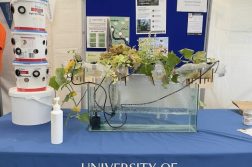Disclaimer: The views expressed within this article are entirely the author’s own and are not attributable to Wessex Scene as a whole.
As researchers around the world race towards the discovery of a vaccine for SARS-CoV-2, the blood of horseshoe crabs is harvested to test the vaccines for bacterial contamination. Although it’s fundamental to find a solution to the current pandemic, the exploitation of horseshoe crabs raises questions about animal welfare and the impact human activities have on biodiversity.
Atlantic Horseshoe crabs are a species of marine and brackish water arthropods, commonly found along the Atlantic coasts of the US and Mexico. They are more related to scorpions and spiders, but they are incorrectly named “crabs” for their similarity to crustaceans in appearance and behaviour. Adults of the species lay their eggs on coastal beaches during spring and summer. The younglings roam offshore on tidal flats before moving deeper in the ocean to feed and complete their maturation. Their cycle ends when they return to shallow waters to spawn.
But what do horseshoe crabs have to do with the COVID-19 vaccine? The blood of horseshoe crabs contains limulus amoebocyte lysate (LAL), a molecule that is used as a test for bacterial contamination. Lysate detects the endotoxins released by bacteria, leading to a clotting process that can show researchers whether the vaccine is safe for human use. If the vaccine solution clots into a gel-like substance after applying lysate, it means bacteria contaminated the solution, which becomes deadly if injected. Because of its high specificity-it can detect concentrations of endotoxins as low as 1 part per trillion- biomedical researchers widely use horseshoe crab blood.
Many problems arise from the use of horseshoe crab blood. First, the animals are caught from the wild. In 2018 approximately 500,000 crabs were trapped in the US alone, decreasing their breeding pool drastically. According to National Geographic, the number of spawned animals dropped from 1.24 million in the Delaware Bay in 1990 to about 332,211 in 2019, classifying the species as vulnerable, just a step away from endangered. Second, the process of extraction lasts between 24 and 72 hours, collecting 30% of the crabs’ blood from a needle placed near their heart. The animals are then released far from their area of collection to avoid re-bleeding, but estimates show that between 10 and 30 percent of animals do not make it once reintroduced. Last, fewer and fewer females go back to shore to spawn. Although scientists are still debating the reason behind this behaviour, it is likely females are left physically impaired and unable to produce eggs.
As the world is getting ready to mass-produce a vaccine for COVID-19, horseshoe crabs’ blood will be on high demand. The company Lonza has created an alternative for harvested LAL. This new technology, known as PyroGene Recombinant Factor C Assay (rFC), can reproduce the effects of lysate by activating the clotting cascade. The European Pharmacopeia has approved the use of this alternative technology, but the US Pharmacopeia has blocked it based on too little information about its effectiveness. Although the new test seems as reliable as LAL, the opposition it faces raises questions on animal welfare.
Researchers introduced the LAL test to avoid the use of rabbits in the testing of vaccines safety. Before LAL was widespread, researchers could only assess the quality of vaccines by injecting them into rabbits and noticing the animals’ reactions to them. If the vaccine contained endotoxins from bacteria, the rabbit would often die and the vaccine deemed unsafe for humans. However, to save rabbits from a painful death, the lives of horseshoe crabs is put on the line.
The extraction procedures are also a concern. As mentioned above, technicians insert a needle in the crabs’ flesh close to the heart to withdraw blood. The crabs are then held in position for hours, as the documentary Crash: A Tale Of Two Species by PBS shows. There is no way to know the pain and fear these animals endure during the extraction, but it’s not a surprise that up to 30% do not survive the process, and between 10 and 30% die once reintroduced in their habitat.
Many are suggesting breeding horseshoe crabs as an alternative to sourcing them from the wild. Although this option seems reasonable and it would allow the wild population to recover from its exploitation, other issues pop up. Apart from the ethical conundrum of breeding an animal to make it go through sufferings and death, housing of horseshoe crabs could become a problem. To go through their life cycle, the crabs move from shallow water, to tidal flats, passing by the depths of the oceans before going back to shore to spawn. The expenses of creating a breeding ground that is even remotely similar to their natural environment would be astronomical. Adding to the expensive extraction procedures, this method would not be profitable. As a result, to keep the costs low, the animals’ wellbeing would be sacrificed by only providing the minimum for their survival.
While I was writing this article, a question kept popping in my mind. Why do we value a species’ life more than another? Rabbits are considered pets in many countries, so it seems logical to think we can sacrifice horseshoe crabs, an alien-like creature, for the rabbit’s sake. This argument becomes even more one-sided when we compare human lives to the crabs’.
I thought the SARS-CoV-2 pandemic would teach us something about the importance of keeping distance from wild animals, so the use of a wild-caught animal’s blood to test a vaccine for a pandemic seems ludicrous. As a scientist in training, I hope we can work towards more sustainable, ethical and responsible methods. And most of all, I hope I will live in a world where animal lives are always deemed worthy of respect.



